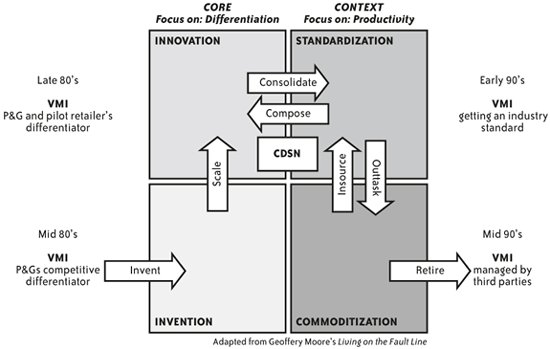Section 10.1. ESA in consumer products
10.1. ESA in consumer productsConsumer product (CP) manufacturers are among the most familiar faces on the front lines of ESA adoption. They face one of the most challenging and competitive landscapes of any manufacturing-based industry. Retailers led by Wal-Mart have consolidated distribution and pricing power, all but dictating the cost structures in which manufacturers must operate. The same pressure forces them increasingly to outsource and offshore their operations, straining their supply chains, while consumer demandwhich goes hand in hand with consumer boredomcalls for ever-proliferating numbers of spinoffs from successful products and brands. This leads to even more strain on product development, supply chains, and manufacturing systems, as the classical model of relatively stable business processes buckles under unpredictable demandsa buckling felt by the underlying IT as well. In its many conversations with customers in the CP industry, SAP has been told again and again that they understand that ESA represents a paradigm shift and is not just another upgrade; that the functionality once packed into a black box is about to be freed from that boxi.e., your classical enterprise application. But they have questions of their own, as it turns out. Yes, they understand that ESA will be a platform, but will it be the platform, and what will it mean for the IT landscape that exists today? They're not afraid of re-rendering their current applications as enterprise services, but they want a detailed roadmap to adoption, and they are demanding real-world examples (not just the theoretical benefits) of how ESA will solve what is rapidly becoming their biggest IT challenge: reconfiguring their landscapes to keep up with business processes that are anything but stable. And there are such examples. Procter & Gamble (P&G) invented the concept and practice of Vendor-Managed Inventory (VMI) in the mid-1980s, effectively differentiating itself with an innovative supply chain process. As shown in Figure 10-1, the evolution of VMI continued to create a competitive edge for P&G, and its first wave of retail partners, until widespread adoption throughout the CP industry ultimately made VMI a critical but nondifferentiating task that could be outsourced successfully to third parties. Figure 10-1. Business process life cycle for Vendor Managed Inventory (VMI) Seeking to leverage more than a decade's worth of investment in its VMI processes, however, P&G sought to reinvent them by decomposing components of the underlying applications and recombining them as composite applications driving its "Responsive Replenishment" process, in which data from even the point-of-sale helps to trigger replenishment at its retail partners automatically. There are other examples as well. One CP manufacturer uses enterprise services to gain a competitive advantage by extending the reach of the global purchasing process to its large supplier base. The result is a standardized purchasing process enabling collaboration partners to manage purchase orders throughout the entire supply chain more efficiently. This process provides business value to both the manufacturer and suppliers by streamlining manufacturing cycle time on the one hand and jointly tackling critical out-of-stock situations on the other. In this example, enterprise services added to a foundation of mySAP ERP, SAP Business Information Warehouse (SAP BW), and third-party purchasing applications lay the groundwork for business process innovation. |
EAN: 2147483647
Pages: 265